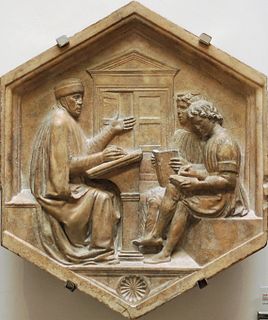
Priscianus Caesariensis, commonly known as Priscian, was a Latin grammarian and the author of the Institutes of Grammar, which was the standard textbook for the study of Latin during the Middle Ages. It also provided the raw material for the field of speculative grammar.

Odilon Redon was a French symbolist painter, printmaker, draughtsman and pastellist.

Abraham Geiger was a German rabbi and scholar, considered the founding father of Reform Judaism. Emphasizing Judaism's constant development along history and universalist traits, Geiger sought to re-formulate received forms and design what he regarded as a religion compliant with modern times.

Adolph Goldschmidt was a Jewish German art historian. He taught at University of Berlin from 1892 to 1903; and University of Halle from 1904 to 1912.
Otto Benesch was an Austrian art historian. He was taught by Max Dvořák and is considered a member of the Vienna School of Art History. He is well known for his catalogue of Rembrandt's drawings. In 1942 he was awarded the Guggenheim Fellowship.

Paul Frankl was an art historian born in Austria-Hungary. Frankl is most known for his writings on the history and principles of architecture, which he famously presented within a Gestalt-oriented framework.
Klaus Gustav Heinrich von Beyme was a German political scientist who was Professor of Political Science Emeritus at the Faculty of Economic and Social Sciences of the University of Heidelberg.
A Wildenstein Index Number refers to an item in a numerical system published in catalogues by Daniel Wildenstein, a scholar of Impressionism, who published catalogues raisonnés of artists such as Claude Monet, Édouard Manet and Paul Gauguin through his family business, Wildenstein & Company. In these catalogues, each painting by an artist was assigned a unique number. These index numbers are now used throughout the art world, in art texts, and on art websites to uniquely identify specific works of art by specific artists.
Emil Kaufmann was an Austrian art and architecture historian. He was the son of Max Kaufmann, a businessman, and Friederike Baumwald (Kaufmann). Kaufmann is best known for his studies of neo-classicism.
Hans Jantzen was a German art historian who specialized in Medieval art.
Wilhelm Vöge was a German art historian, the discoverer of the Reichenau School of painting and one of the most important medievalists of the early 20th century. Whitney Stoddard called him the "father of modern stylistic analysis" for medieval art.

André Mellerio (1862–1943) was a French art critic who promoted the cause of Symbolism and "idealist" art and appeared in two pictures by Maurice Denis. He was the biographer, and great friend, of Odilon Redon.

Klaus Hentschel is a German physicist, historian of science and Professor and head of the History of Science and Technology section in the History Department of the University of Stuttgart. He is known for his contributions in the field of the history of science.
Janick "Jan" Krugier was a Polish born Swiss dealer in modern art most known for his relationship to the works of Pablo Picasso and a survivor of the Holocaust.

Jan Białostocki was one of the most famous Polish art historians of the 20th century.
Martin Warnke was a German art historian.
Hans Tietze was an Austrian art historian and member of the Vienna School of Art History.
Lottlisa Behling was a German art historian and botanist.
Peter H. Brieger was a German art historian who emigrated to Canada in 1936 to escape persecution from the Nazi regime because of his Jewish family background. He taught at the University of Toronto from 1936 to 1969, was Head of the Department of Fine Art from 1947 to 1964, and Chair from 1965 to 1969. He was a medievalist, specialising in 12th and 13th century manuscripts.







